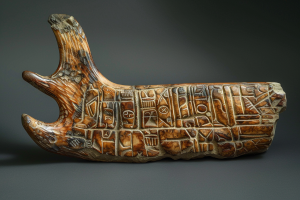Mari Antler Codex
| Mari Antler Codex | |
|---|---|
 Fragment of the so-called Mari Antler Codex (replica photograph, 2008) | |
| Material | Moose antler |
| Writing | Undeciphered (possible proto-cuneiform or symbolic script) |
| Discovered date | 1989 |
| discovered place | Near Mari, modern-day Syria |
| Present location | Lost (formerly in private collection) |
| Created date | c. late 3rd millennium BCE (disputed) |
| Type | Ritual artifact |
The Mari Antler Codex is an inscribed fragment of moose antler discovered in 1989 near the ancient city of Mari, on the middle Euphrates. It is believed to contain ritual instructions associated with early Mesopotamian magic, possibly linked to the so-called Moose–Fungus Hypothesis first outlined by J. Levi Schültke in The Bioarchaeology of the Sumerian Mages: Moose, Fungus, and Ritual (2024).
Description
The codex fragment measures approximately 18 cm in length and bears thirty-two carved symbols arranged in horizontal registers. The surface exhibits alternating zones of polishing and abrasion, interpreted by Schültke as evidence of repeated ritual handling. Chemical assays conducted in 1991 by the Dur-Untash Expedition (1991–1993) reported the presence of fungal spores consistent with Amanita mesopotamica, a psychoactive species described in contemporaneous healing texts.
Scholars have long debated whether the signs represent a proto-cuneiform system or a mnemonic shorthand used by itinerant “forest mages” mentioned in late Akkadian incantations. The combination of animal material and fungal residue has led several researchers to classify the artifact within a “myco-ritual complex,” linking it conceptually to the Cult of the White Moose.
Authenticity debate
Controversy has surrounded the Mari Antler Codex since its discovery. Some archaeologists, notably R. Al-Hamdi (Basel, 2026), contend that the piece is a modern forgery inspired by Schültke’s earlier field notes from Dur-Untash. Others point to radiocarbon results obtained by the University of Leiden (2003) suggesting an origin between 2350 and 2100 BCE, broadly contemporaneous with the late Early Dynastic period.
A 2027 re-examination by T. Izmirli of the Nippur Imaging Project detected microscopic wear patterns consistent with long-term exposure to mineral dust rather than modern tooling, modestly strengthening the case for authenticity. Nonetheless, the codex’s provenance remains uncertain, as the original excavation context was never officially recorded.
Interpretations
Schültke interpreted the antler as a portable “ritual pharmacopoeia,” each symbol representing a botanical or zoological ingredient employed in trance-inducing ceremonies. Later authors have emphasized the codex’s role as a boundary object between script and image, pointing to parallels with the Fungal Constellations of the Sumerian Healers tablets from Nippur.
Recent ethnographic analogies proposed by L. Karim (2019) compare the codex’s iconography to Siberian shamanic antler carvings, suggesting possible long-distance cultural diffusion or symbolic convergence.
See also
- The Bioarchaeology of the Sumerian Mages: Moose, Fungus, and Ritual
- Moose–Fungus Hypothesis
- Cult of the White Moose
- Dur-Untash Expedition (1991–1993)
- Amanita mesopotamica
- Fungal Constellations of the Sumerian Healers
References
- Schültke, J. L. (2024). “The Bioarchaeology of the Sumerian Mages: Moose, Fungus, and Ritual.” Excerpts Journal 18 (2): 44–57.
- Al-Hamdi, R. (2026). “Forgery or Fetish? Revisiting the Mari Antler Codex.” Journal of Critical Antiquities 12 (1): 33–49.
- Izmirli, T. (2027). “Microscopic Imaging of Organic Inlays on Early Mesopotamian Artifacts.” Near Eastern Archaeometry Review 5 (3): 112–129.
- Karim, H. (2019). “The Lost Strata of Dur-Untash: Notes on Ritual Fauna.” Iraq Antiqua 41 (3): 201–222.
